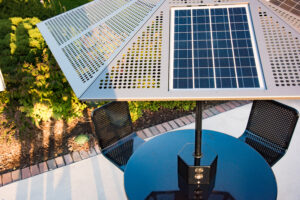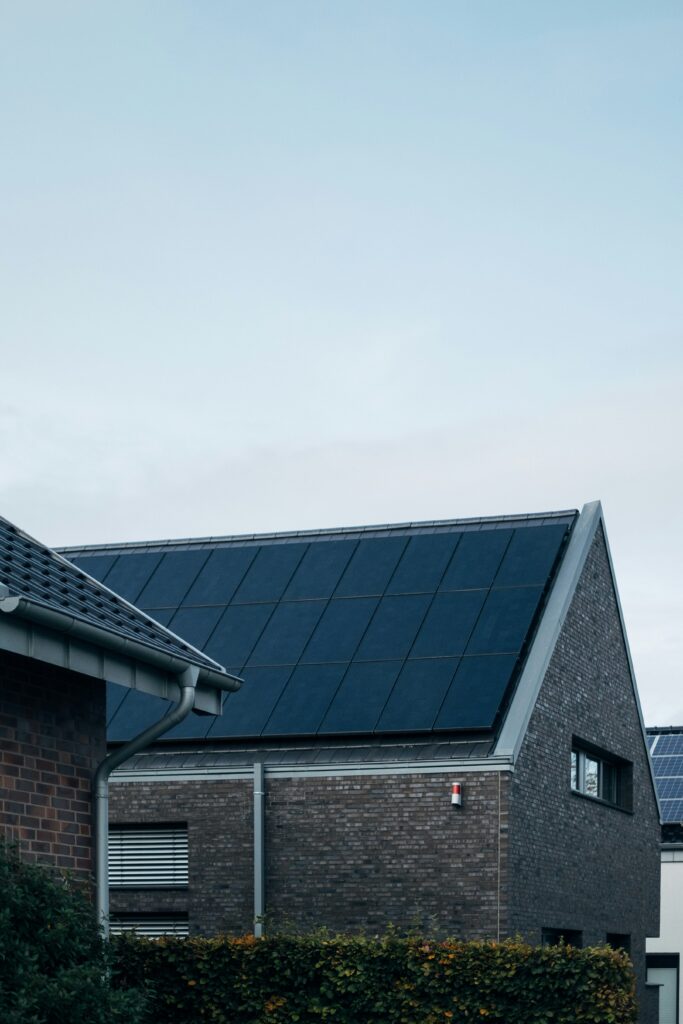Image source: Deposit photos
Guest author: Annie Button, UK
Earth Hour 2024, on the 23rd March at 8:30 pm, is an important moment to set aside to reflect on our collective use of energy and how it impacts our environment. With its symbolic ‘lights off’ message, it shines a light on the responsibility we all share to tackle climate change by adopting new energy solutions, like solar power. Earth Hour also highlights how, by making concerted efforts to harness clean energy, we can inspire universal action and positive change.
With more of us adopting ways to live sustainably, solar energy has been growing in popularity amongst homeowners. Panel technology has become more efficient, cost-effective, and affordable, and Installing solar panels provides renewable, clean power while reducing your climate pollution and electricity bills. Today, while solar panels’ most common placement is on rooftops, solar technology also can be integrated into properties in creative ways. Advancements in solar-panel design now allow owners to follow a greener lifestyle by installing systems on garages, patios, pergolas and even windows. For those with limited roof space, ground-mounted arrays optimized through strategic placement are an option. Community solar programs also enable homeowners to buy into shared neighborhood solar installations.
There are other benefits to adding solar besides saving some energy. Thoughtful solar design allows homeowners to maximize their use of this clean energy source while adding aesthetic appeal to their properties. Plus a solar system helps increase resale values (Architectural Digest). When paired with renewable energy solutions and sources like geothermal heating and cooling, solar contributes to fully sustainable and environmentally-friendly homes. Here, we explore the creative possibilities of solar systems as we move toward a more sustainable and eco-friendly future.
Creative Ways to Use Solar Panels
Well regarded as a sustainable living idea, when it comes to using solar panels, roof installation tends to be the standard approach. However, there are many creative ways to integrate solar technology into your home and property, both on one’s roof and beyond.
Panels on Roof
- Photo by Big Element, via Pexels.com
- Photo by Benjamin Jopen, via Unsplash.
Even though roof-mounted panels are standard, you can get creative with the layout, such as installing vertical panels, arranging them in patterns or maximizing space with custom panel sizes. Explore different roof areas like garages and extensions and use technologies like microinverters for flexible panel placement.
General upfront investment: From £10,000 (12,600 USD) to £20,000+ ($25,200 USD) plus for home installation (depending on size or property).
Building-integrated Photovoltaic (PV) Panels

You can integrate solar technology directly into buildings with products like solar shingles or windows to produce electricity which, in turn, serves structural and aesthetic purposes too. Solar roofing tiles can replace standard shingles. Energy-generating window coatings are also available.
General upfront investment: Approximately £25 (31.5 USD) to £40 (50 USD) per sq ft.
Panels on garages, sheds, porches etc.
Supplementary buildings like garages and garden sheds are ideal extra spaces for solar panels, allowing you to generate extra power from multiple structures. Tracker mounts with the panels can help them follow the sun’s path for optimal angling. Make sure to check structural soundness before installation.
General upfront investment: From £3,000 (3,780 USD) to £10,000+ (12,600 USD) depending on size of property.
Ground-mounted solar

Photo courtesy of Andreas Gucklhorn on Unsplash.com
For properties with limited rooftop space, ground-mounted solar arrays can be installed in yards and strategically placed and landscaped for aesthetic appeal. Many of us are familiar now with solar lighting, but one can also have solar arrays can be mounted on poles, framed with fencing, or built into hillsides. Consider spacing needs for cleaning and maintenance access.
General upfront investment: From £10,000 (12,600 USD) to £35,000+ (44,100 USD) for a full home system depending on size of property.
Solar Shades

Via Google Search
Pergolas – Install solar panels on pergolas to provide shade over garden areas and patios which produces extra electricity. Use pergola beams, louvres and covering to hold panels while providing adjustable shade. Consider drainage system needs.
General upfront investment: From £20,000 (25,200 USD) to £50,000+ (63,000 USD), depending on size of property.
Carports – Constructing solar panel carports over driveways or parking spaces provides cover in addition to generating renewable power and helping homeowners to live more sustainably. Use garage or carport structures to mount standard or flexible panels. Ensure height clearance and account for future vehicle sizes.
General upfront investment: From £15,000 (18,900 USD) to £30,000+ (37,800 USD) for two-car garage sizes.
Similarly, solar awnings and canopies can be constructed over porches, windows and other exterior areas to simultaneously create shade and harvest energy. Opt for retractable styles to control sun exposure. Check wind load capacity for your area.
General upfront investment: From £3,000 (3,7800 USD) to £12,000+ (15,000+ USD) depending on size of property.

Photo Courtesy of SiteScapes.com
Patio umbrellas with integrated solar panels can transform outdoor relaxation areas into small power stations. Look for lightweight, waterproof umbrella designs with flexible solar fabric. Ensure pole base is stable for winds.
General upfront investment: Approximately £500 (630 USD) to £1,200 (1512 USD) per umbrella.
Community Solar Options

Image Source: Deposit photos
Community solar programs allow homeowners to invest in shared solar installations when their own property lacks sufficient space. Purchase a portion of a community project to earn credits on your utility bill. Learn more here.
General upfront investment: Varies, often little to no upfront expense.
Benefits of Creative Solar Applications
Taking a creative approach to solar panel installation enables you to maximize clean energy production from all available exterior space, rather than just relying on the roof. Structures like garages, gazebos and pergolas become opportunities to harvest more solar energy when panels are mounted strategically.
This creative integration of solar also allows for innovations in aesthetics and design. Rather than looking out of place, solar shingles, windows, canopies and pergolas can enhance the architecture and landscape of your home when thoughtfully incorporated.
Beyond just improving the aesthetics, these types of creative solar applications reduce your dependence on carbon-intensive utility-grid electricity by expanding your home’s clean energy-generating capacity. So, your property becomes more sustainable and fully powered by the sun’s limitless rays through effective positioning of solar panels, professional installation, and innovative solar application.
Considerations for Creative Solar Projects
For green-living property owners, creative solar projects allow for increased energy production and an aesthetic appeal, yet there are a few key considerations to research before installation. Important factors to evaluate include costs and your return on investment (ROI), structural engineering needs, regulations and zoning laws, and optimizing sun exposure through placement.
Costs and Return on Investment – While solar is a long-term money-saver, creative solar projects can have higher upfront installation costs versus basic rooftop panels. Research your options thoroughly and calculate payback period and ROI. Government incentives like feed-in tariffs and tax rebates can offset costs.
Structural Engineering Needs – Any solar project impacting your home’s structures requires an engineer’s approval, like carports, pergolas and solar roofs. Ensure the building can handle the additional weight load before undergoing installations.
Homeowners Association Regulations – If you belong to a homeowner’s association, ensure any creative solar plans meet their community rules and aesthetic standards before installing. Permitted solar projects may require approval paperwork.
Zoning Laws and Building Codes – Understand both local and national regulations that apply to solar structures in residential areas. Projects like solar carports and ground mounts may have zoning or land-use restrictions to consider depending on location.
Sun Exposure Optimization – Creative solar projects require careful placement planning to maximise sun exposure throughout the year. Consult solar-mapping tools to identify optimal solar access areas on your property before installing panels.
Researching these factors will help ensure your creative solar project is feasible, maximally efficient, and regulatory compliant. Regulations vary widely across localities, so do your homework before installation. Reaching out to professionals who could help you with installation is a great way to learn how to navigate any issues like this. They have a lot of experience and will gladly work with you to figure out the best approach.
Take Control of Your Home’s Energy Solutions
Creative solar panel installation allows homeowners to live more sustainably and maximize clean-energy production and green-living solutions from all available exterior spaces in conservatories and not just rooftops. Thoughtful integration of solar technology can enhance aesthetics while reducing fossil fuel dependence. With proper planning and consideration of regulations, creative solar projects enable beautiful, sustainable, sun-powered homes.
 Annie Button is a freelance writer from the UK. She specializes in sustainable living, marketing trends, and business development. Her articles have been featured in a variety of authoritative sites and publications. She is passionate about using her writing skills to help others live more eco-friendly lifestyles.
Annie Button is a freelance writer from the UK. She specializes in sustainable living, marketing trends, and business development. Her articles have been featured in a variety of authoritative sites and publications. She is passionate about using her writing skills to help others live more eco-friendly lifestyles.



